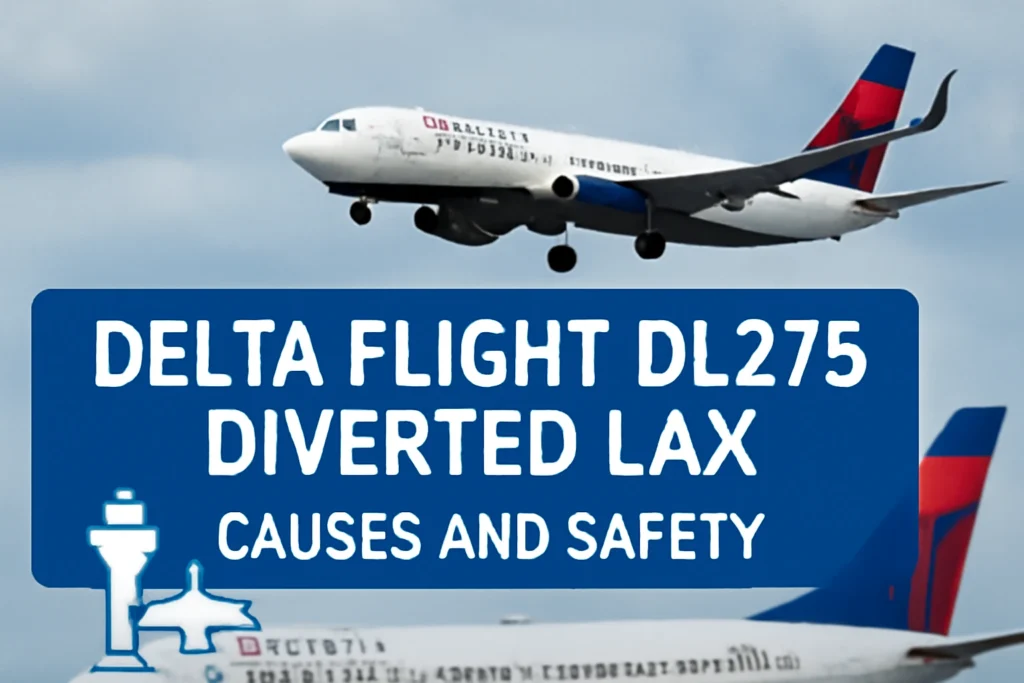Delta Flight DL275 Diverted to LAX – Overview
Delta Flight DL275 diverted to LAX on May 28 after the Airbus A350’s engine anti-ice system detected a potential malfunction mid-flight over the Pacific Ocean, prompting the crew to take precautionary measures that ensured a safe landing. Passengers and crew experienced a precautionary but smooth emergency landing at Los Angeles International Airport, highlighting the importance of aviation safety and real-time monitoring, which ultimately ensured Delta Flight DL275 landed safely. Delta Airlines’ swift response, supported by maintenance facilities and predictive checks, underscores lessons in long-haul flight management, anti-ice system reliability, and the broader aviation industry’s focus on preventing mechanical issues while ensuring passenger care and operational efficiency.
Flight Details of Delta DL275
Route and Aircraft Information
Delta Flight 275, operated by Delta Air Lines, is a trans-Pacific journey using the Airbus A350, departing from Anchorage and scheduled to land at Los Angeles International Airport (LAX). This long-haul flight over the Pacific Ocean highlights the complexity of international air travel and the importance of real-time monitoring for aviation safety, especially in the context of Delta’s maintenance protocols.
Reason for Diversion
During the flight, the engine’s anti-ice system detected a potential failure, prompting precautionary measures by the flight crew. The system, designed to prevent ice formation on the Rolls-Royce Trent XWB engines, played a crucial role in identifying the issue before it became critical, ensuring passenger safety and operational reliability.
Timeline of Events
Mid-flight, the crew confirmed the system alert and made the decision to divert to LAX on May 28. Passengers experienced a precautionary but smooth emergency landing at Los Angeles, demonstrating Delta’s focus on long-haul flight safety, predictive maintenance, and the aviation industry’s commitment to minimizing mechanical risks while maintaining passenger care.
Passenger Experience During Diversion

Safety Precautions
Passengers aboard Delta Flight DL275 received careful attention as the flight crew implemented strict safety precautions during the diversion to LAX. Coordinated with guidance from the Federal Aviation Administration, the crew ensured that all passengers followed protocols while maintaining calm and comfort. Real-time monitoring and clear communication played a critical role in upholding aviation safety, highlighting Delta Airlines’ commitment to passenger care on long-haul flights.
Rebooking and Assistance
Following the precautionary landing at Los Angeles International Airport, according to Delta, offered rebooking options and dedicated customer support for affected passengers of flight DL275. While the diversion caused minor disruptions, measures such as alternative flights, updated schedules, and responsive assistance minimized inconvenience. The event also provided lessons on managing the financial impact for both the airline and passengers, emphasizing operational efficiency and proactive service in handling unplanned flight diversions over international routes.
Lessons from Delta Flight DL275
Aviation Safety Improvements
The diversion of Delta Flight DL275 underscores the critical importance of anti-ice system maintenance for Airbus A350 aircraft. Regular inspections and proactive checks prevent ice formation on engines, reducing in-flight risks. Additionally, AI-powered predictive maintenance systems enhance safety by analyzing real-time data, allowing Delta Airlines to anticipate potential issues and act before they affect long-haul operations.
Operational Preparedness
This incident offers key lessons in aviation operational preparedness, especially for trans-Pacific flights. Flight crews make swift, informed decisions during emergencies, protecting passenger safety and minimizing disruptions. Preventive measures, combined with well-practiced emergency landing procedures, demonstrate how Delta Airlines and the aviation industry at large prioritize reliability, long-haul flight management, and continuous improvement in flight safety standards.
Technical Aspects of the Incident
Anti-Ice System of Airbus A350
The Airbus A350 on Delta Flight DL275 relies on its engine anti-ice system to prevent ice formation on the Rolls-Royce Trent XWB engines during long-haul flights over cold regions like the Pacific Ocean. This system circulates heated air to critical engine components, ensuring smooth operation and minimizing the risk of mechanical failure. Regular maintenance and predictive monitoring of these systems are essential to maintain aviation safety and prevent mid-flight diversions.
Real-Time Flight Tracking and Response
Delta Airlines employs real-time flight tracking technology to monitor aircraft performance and detect potential issues early. During the DL275 diversion, coordination with major Delta hub maintenance facilities allowed the crew to take immediate corrective action, ensuring a safe landing at Los Angeles International Airport (LAX). This approach highlights the importance of predictive systems, operational readiness, and effective communication in managing unplanned flight events.
Impact on Delta Airlines and Aviation Industry
Financial and Operational Implications
The diversion of Delta Flight DL275 had notable financial and operational impacts. While the safe landing at LAX prevented potential hazards, the airline incurred costs related to the unscheduled diversion, flight cancellations, and rebooking affected passengers. Handling such incidents efficiently requires coordination across Delta’s maintenance teams and flight operations. Delta Airlines operations, maintenance facilities, and customer service teams, emphasizing the importance of strategic planning for long-haul flights and real-time response in the aviation industry.
Broader Lessons for Airlines
Events like the DL275 diversion reinforce how Delta’s maintenance practices and operational preparedness for long-haul flights can prevent incidents. aviation safety standards can be improved through continuous monitoring, preventive maintenance, and AI-assisted predictive systems. Transparent communication and proactive measures also enhance passenger trust in Delta’s ability to manage flight status during emergencies. passenger trust is enhanced when airlines like Delta communicate effectively about flight status and safety measures. and protect airline reputation, showing that prioritizing safety and operational preparedness is crucial for maintaining confidence in international air travel and long-haul flight management.
How AI Can Support Integrated ISO Audits
Predictive systems in aviation maintenance, like those used on Delta Flight DL275, share similarities with AI tools in other industries. These systems monitor engine performance in real-time, detect anomalies early, and help crews make informed decisions to prevent failures. For insights into AI-driven monitoring in operational systems, read more here, highlighting how predictive technology enhances safety and efficiency both in aviation and integrated ISO audits.
Explore More Aviation Insights
Understanding flight safety, emergency diversions, and maintenance procedures can deepen knowledge of the aviation industry. For additional articles and resources on aviation, operational lessons, and safety standards, visit Techy Infinity. These resources complement the lessons from Delta Flight DL275, demonstrating how real-time monitoring, preventive measures, and predictive systems play a key role in both airline operations and broader industry practices.
FAQs
Why was Delta DL275 diverted?
Delta Flight DL275 was diverted to LAX on May 28 due to a potential engine anti-ice system failure, ensuring passenger safety and safe landing during the trans-Pacific flight.
What is an anti-ice system?
The engine anti-ice system prevents ice on Rolls-Royce Trent XWB engines, crucial for aviation safety on long-haul flights like DL275.
How was passenger safety ensured?
The flight crew followed FAA guidance, implemented safety protocols, and managed passenger care during the diversion to LAX.
Which aircraft operated DL275?
Delta DL275 was operated using an Airbus A350, equipped with advanced predictive maintenance systems.
Were flights canceled due to diversion?
Some Delta flights were rescheduled, but passengers were quickly rebooked and assisted.
How does Delta use AI for maintenance?
AI-powered predictive systems monitor engines in real-time, similar to the anti-ice system, preventing failures on flights like DL275, which could have cost Delta Airlines significantly.
What lessons does DL275 teach?
The incident highlights aviation safety, preventive maintenance, and operational preparedness for long-haul flights are crucial for ensuring that flights like Delta Flight DL275 land safely.
What was the financial impact?
Costs included diversion handling, cancellations, and passenger support, showing the operational impact on Delta Airlines.
Conclusion
The diversion of Delta Flight DL275 to LAX highlights the critical importance of passenger safety, the reliability of the engine anti-ice system, and the role of AI predictive maintenance in long-haul aviation. Delta Airlines’ proactive response and real-time monitoring ensured a smooth and safe landing, demonstrating the airline’s commitment to passenger trust and flight status updates. aviation safety. This incident provides valuable lessons for the aviation industry, reinforcing the need for preventive measures, operational preparedness, and advanced systems that protect both passengers and aircraft during international flights.


